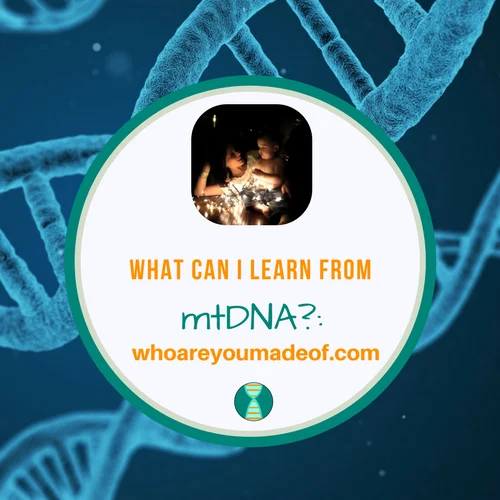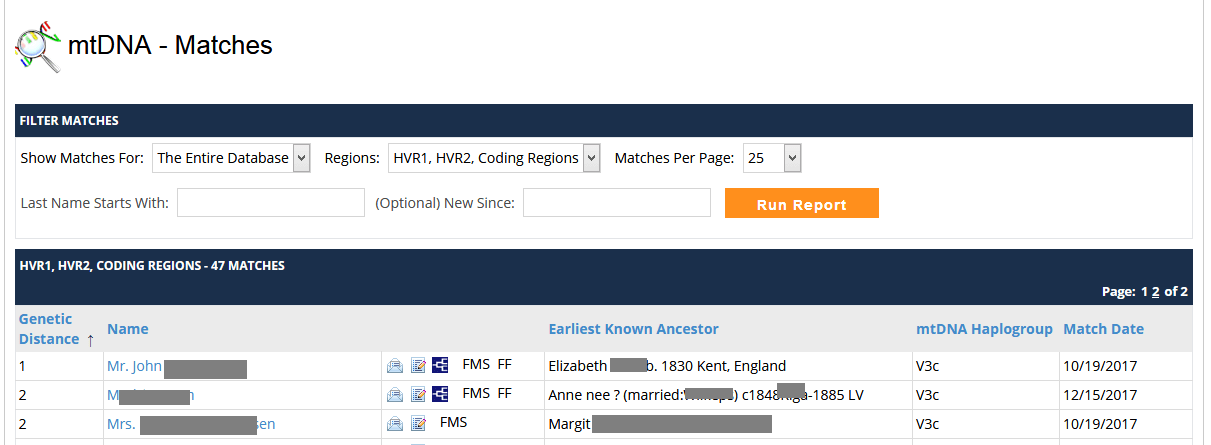While it is true that there are many things that mtDNA can’t tell us about our family history, it is a nice tool to add to the genealogy toolbox. In this post, we’ll explore what you can learn from mtDNA.
One of my main research projects in my mother’s family is tracing back her mother’s German ancestry. At a certain point, I felt like I had reached the limit of what autosomal DNA testing could tell me about my mother’s deep ancestry, and I determined that I would start to explore mtDNA.

Autosomal DNA testing is fantastic, and I love it, but I don’t have many DNA matches on my mother’s German side of the family. Since autosomal DNA can only “reach” back several generations, I am interested in casting a bigger net, so to speak.
I’m interested in finding DNA matches that go back much, much further. Even if the common ancestors with my mtDNA matches are too far back to find the connection, it will still give me a good idea of where I should be looking for my mother’s maternal German ancestors.
What is mtDNA?
Most of our DNA is contained within our numbered chromosomes located in the nucleus of our cells, but there is a small exception. A mitochondria is a small organelle that is contained within your cells.
The main purpose of the mitrochondria is to provide energy to the cell. We all inherit mitochondrial DNA from our mothers, since it comes from her egg.
Cool fact: There is evidence that the mitrochondria is a remnant of a free-living bacteria. The evidence of this is actually the existence of the small amount of DNA contained within the organelle, which is what we call the mtDNA.
Who can take a mtDNA test?
Both females and males can take the mtDNA test because everyone, both male and female, inherits mtDNA from their mother. Mitochondrial DNA results reveal information about our direct-line maternal ancestors.
There is only one test that can only be taken by only one gender, and that is the Y DNA test (or the “Big Y” as it is called), since females don’t have the Y chromosome.
The other really neat thing about a mtDNA test is only one female in the family line really needs to take it, since the DNA is passed down intact. This means that since I took the mtDNA test, my children will not need to take this test, since they will already know their mtDNA haplogroup.
My mtDNA will continue to pass down through future generations to my daughter, and her daughters, and her granddaughters. If my sons end up having children when they are is an adults, their children will not share a mtDNA haplogroup with me, however, since they will inherit their mtDNA from their mothers.
What can mtDNA tell me?
I just recently received the results back, and have begun to decode and explore the ancient information contained within my mitochondria. The furthest that I have been able to trace back on my mother’s family tree is my great-great-great-great-great grandmother, Elizabeth Puster, who was born in Germany in 1800.
She died in New Jersey in 1854. The mtDNA can only tell me about my straight maternal line, meaning that this 5 X great-grandmother is the mother of the mother of the mother of the mother of the mother of my mother.
The idea is that the mtDNA test might be able to help me know where to focus my research efforts. Does her maternal line continue in Germany, or does it follow into another country?
The results of the mtDNA test will only be able to tell me about a tiny percentage of my ancestors, but the information is still valuable. Mitochrondrial DNA is passed down identically from mother to daughter and mutates very, very, very slowly.
The Family Tree DNA mtDNA test is able to distinguish between these very tiny mutations, and so I have mtDNA matches, grouped into different “genetic distances”.
Can I use mtDNA for genealogy?
As I mentioned before, the mtDNA is only passed down through the maternal line. Even so, there are still some legitimate uses for mtDNA in genealogy. For example, I have been provided with a list of mtDNA matches:

I can use these matches to follow my definitive maternal line all the way back to wherever it might lead. On the left side of the list, you can see a column called “genetic distance”.
Basically, the further the genetic distance, the more “different” the mtDNA is (in a very small way), meaning the further back our common maternal ancestor. Many of the test takers are very serious about genealogy and genetic genealogy and have substantial, documented family trees.
This is helpful for someone like me, who is interested in using mtDNA for genealogy.
The other major use for mtDNA is to verify that people are descended from the same maternal ancestor. mtDNA is great for this, since both men and women inherit this type of DNA. If take the example of my great-great-great-great grandmother, anyone who is descended from her in a straight female line will share the same haplogroup.
If someone doesn’t, then we know that they are not really descended from her and additional research needs to be done.
What are the limitations of mtDNA?
Since the mtDNA can only tell me about my direct maternal line, it only covers a very small percentage of my ancestors. A tiny percentage!
Additionally, as the genetic distance in mtDNA grows, we will have more and more DNA matches.
Just because we share an mtDNA haplogroup, it doesn’t mean that this is the only way in which we are related. We could have a maternal ancestor from thousands of years ago, but also be descended from a set of common ancestors on our paternal side.
We can also share mtDNA and not share autosomal DNA, or share autosomal DNA and not share mtDNA. Mitochondrial DNA is a whole new world, and while there is a lot more for me to learn about it, I’m very excited about this adventure.
Note: mtDNA is much more technical than an autosomal DNA test, and so the results are a little more complicated to wade through – but I love learning and have enjoyed the process.
How to get a mtDNA test?
If you are interested in doing your mtDNA (whether you are male or female, remember – everyone can do this test!), I recommend testing with Family Tree DNA. They are, by far, the best company for this test.
They have expertise in this field, and a substantial database of mtDNA testers, and maintain a separate database where you can transfer your mtDNA data to be compared with test takers from other companies.
If you are male, you can get a bundle test with Family Finder, Y DNA, and a Full Sequence mtDNA, or you can just get the mtDNA, if that is all you are interested in.
Conclusion
I hope that this post gave you some ideas about how mtDNA might be able to help you further your family tree research. If you have any questions, something to add, or just want to share your experience with mtDNA testing, I would encourage you to leave me a comment below.
Thanks for stopping by!


Dee
Wednesday 17th of May 2023
When I received my DNA test back I was in total shock. I knew about the English, Scots, Irish and Native American. I knew Pochahauntas(spelling) was a grandmother as she married my grandfather Pettus. Not sure if I want to do the mtDNA test especially since I received another update showing that I was #12 on the Neanderthal list.
Dee
Wednesday 17th of May 2023
My DNA shows 61 countries in Europe, 4 in Africa and starting with the Vikings all the islands between there and Africa plus 6 Native American Tribes. Also the East, South and West Coasts of America. I couldn't believe it when I got it back.